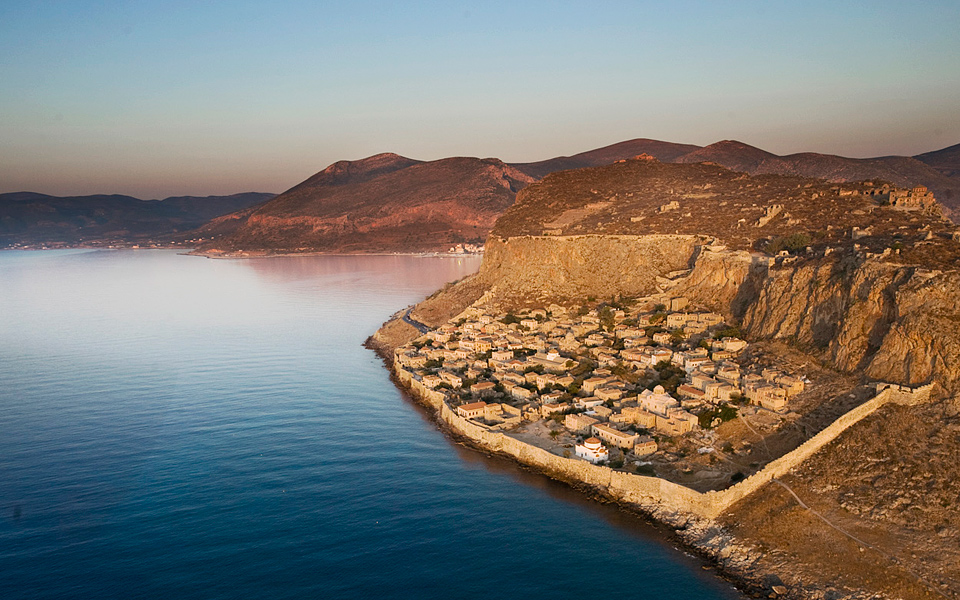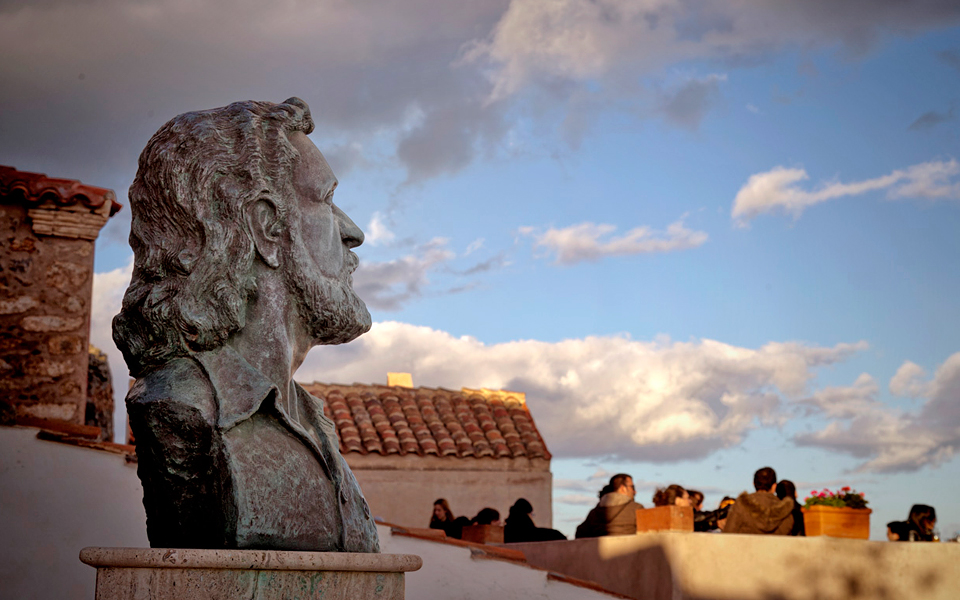Inside Euphoria Retreat’s Visionary Longevity Festival in Mystras
A soulful celebration of longevity, blending...

Monemvasia with its endless view of the Myrtoan Sea is a destination that charms any visitor
© Olga Charami
In all honesty, I had avoided visiting Monemvasia, the medieval castle town on the southeastern coast of the Peloponnese, for many years, fearing the place had become an overly sentimental, somewhat superficial and clichéd destination, suitable only for lovebirds.
I eventually decided to go. It was winter and I went alone. And I ended up turning into a cliche – I felt overwhelmed by this magical place’s rawness, wildness, history and profound romanticism. I have since returned in spring, summer and autumn, both with company and alone, as Monemvasia is an all-year destination, ideal for all emotional states.
Its uniqueness and its fairytale atmosphere (the cliches I mentioned before) remain as true as ever. Even if you haven’t studied its history, you see it written on the walls around you. The sense of isolation felt on this legendary rock, cut off from the coast of the Peloponnese by an earthquake in 375 AD, adds to the wonder.
As a natural fortress, it was inhabited and soon became a strategic fortress claimed the Byzantines, Franks, Venetians and Ottomans. Neither museum-like nor artificially fabricated, Monemvasia is Europe’s only castle that has never ceased being inhabited.

The sense of isolation felt on this legendary rock, cut off from the coast of the Peloponnese by an earthquake in 375 AD, adds to the wonder
© Perikles Merakos
Behind the limestone with which it is built, around 15 people are permanent residents, but many more come and go daily. As for visitors, that goes without saying.
Visitors began trickling here in the 80s and, fortunately, the Ministry of Culture had already taken protective measures before Monemvasia became too touristic. Prior to this, very few people enjoyed its beauty, mainly those from the world of art and literature who came to pay homage to the celebrated 20th century Greek poet Yiannis Ritsos, also an active member of the Greek Resistance during World War II, who hailed from Monemvasia.
The first wave of visitors found hospitable signs of life thanks to Mrs Matoula, a legendary granny who kept the castle lit and served the tourists an unforgettable rooster with noodles recipe at her café.
Measures imposed by archaeological authorities have spared the medieval destination of urban sprawl and distasteful modern buildings. “To be granted a restoration permit, one must submit the original plans of a house or photographs, if they exist, otherwise a detailed depiction of the ruins and a plan based on the castle’s architecture are required. The beauty and the preservation of the area interests us too.” explained Yiannis Charamis, a veteran contractor who spent 50 years working on restoration projects of mansions here with two architects, Alexandros and Hari Kalligas, as his associates.

Measures imposed by archaeological authorities have spared the medieval destination of urban sprawl and distasteful modern buildings
© Olga Charami

The sight of waves crashing onto the rugged walls is captivating
© Olga Charami
It’s impressive that, amid these challenging economic times for Greece, a public restoration project launched five years ago at the Monemvasia castle was completed just a few months ago. Locals credit Lina Mendoni, a former general secretary at the Ministry of Culture who adores the castle, for the accomplishment.
It’s delightful to stroll along the cobbled paths amid the mansions and Byzantine churches while gazing out to the Myrtoan Sea and losing sense of time. Horses transporting supplies may be seen early in the morning, while the dimly lit alleyways can almost conjure up images of knights.
Given this sense of mystery, it is no wonder that Monemvasia ranks as a major attraction for couples. “About 90 percent of visitors are couples. Indeed, according to tradition, wedding ceremonies that take place inside the castle result in solid marriages,” remarked Vassilis Ardamis, a guesthouse owner. However, travelers considering a visit alone should not hesitate. The magic is felt by all.

The central square, where the Christos Elkomenos church and the canon are located
© Olga Charami

A bust of Greek poet Yiannis Ritsos who hailed from Monemvasia
© Olga Charami

At the entrance of the castle the road leads to the main commercial stretch
© Olga Charami
Monemvasia, on the edge of the rock, is reached by crossing a bridge. Cars are left at the main gateway (Kentriki Pyli), or “moni emvasi”, meaning the only entrance, hence the destination’s name. Instructions for exploring the town are not necessary. Just stroll through any alley you see, and keep a look out for terraces with sensational views of the Myrtoan Sea below.
The central cobbled street running through the town always served as a main commercial stretch with small tavernas, cafes and shops offering souvenirs and traditional products. It leads to a clearing filled with sunlight on good days where tourists love to sit. On the one side is the 6th century Christos Elkomenos church, featuring the heavily guarded icon of the Crucifixion – considered one of the most impressive of the Palaiologian Renaissance. A mosque, that nowadays hosts the archaeological collection of Monemvasia, is situated on the other side. In between is the canon, a favorite photo spot for honeymooners and others.
The Ritsos family residence, not open to the public, is located close to the castle town’s entrance, as are many churches. It is said that a total of around 40 churches existed in the past. They now number 24, according to rough estimates. Along with the Christos Elkomenos, the gothic-tinged Panaghia Myrtidiotissa, aka Kritikia, and the Panaghia Chrysafitissa, next to the sea wall, are the stand-out churches.

The Aghia Sofia church which dates back to 12 th century
© Olga Charami
From here, head down to the Portello, the gate which leads to the sea which was once the passageway for traded goods. These days, this rocky location serves as the Monemvasia beach. The sight of waves crashing onto the rugged walls is captivating.
A lesser known route is that which you take coming out of the eastern walls of the settlement until the lighthouse of 1896, which was recently restored. Though demanding, it is worth also taking the voltes route, an uphill zigzagging cobbled path leading to Ano Poli, the uninhabited upper part of the town which offers a spectacular view. The best time to be there is in the afternoon, just before the sunset. Unfortunately, ever since restoration work began in the area, the archaeological service locks the entrance at 14:30.
The first part of the rock to be inhabited was its upper part. The acropolis, once Monemvasia’s wealthier district, is located on the edge as a dilapidated remnant. The 12th century Aghia Sofia church is all that remains, standing 300 meters above sea level. Though restoration work has been completed, the monument is not open to the public.
Unlike other archaeological sites around Greece, the magic at Monemvasia continues well after sunset. Nighttime walks under the moonlight and visits to tavernas, serving local Malvazia wine, are ideal here; a place where different eras continue to co-exist in a magical way.
Monemvasia is 300 km from Athens (a round trip by car including fuel and tolls costs around EUR 80) and 750 km from Thessaloniki (a round trip with fuel and tolls costs around EUR 200)
A soulful celebration of longevity, blending...
Whether by foot, car, or the...
A historic hotel redefines modern Greek...
Just two and a half hours...